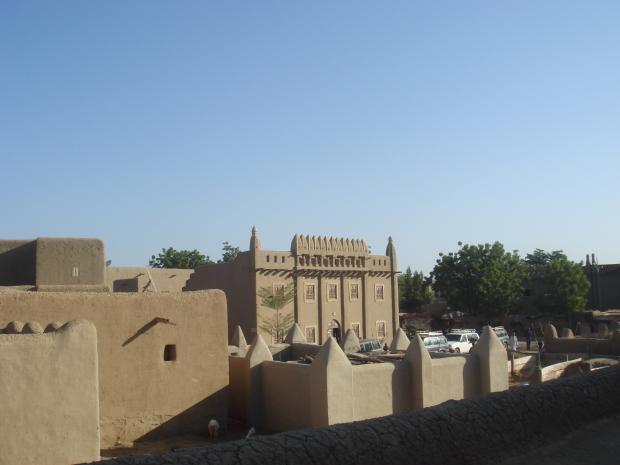Update from Djenne
Djenne, the Malian mud city that the world forgot.
Sophie Sarin, Project leader Endangered Archives Programme, EAP488
Djenne, 6 February 2013
In the midst of Mali’s sudden emergence in the world ‘s focus, the Unesco World Heritage city of Djenne sits tranquil in the heart of the Niger delta, just 120 km South of Sevaré, the launching pad for the continued French air strikes into the North of Mali, where pockets of Islamist rebels are still present.
Yelfa, Grand Marabout de Djenne, whose father served as the town’s Imam laughed when asked what he would do if the Islamists came to Djenne, “I will just continue as normal. Our fathers have seen empires rise and fall here, but Djenne does not change.”
Djenne, with its monumental mosque and its unrivalled Sahel mud architecture has traditionally been regarded as the ‘twin sister’ of Timbuktu, with which it shares a glorious past as an important city of scholarship and commerce. Interestingly, while the world regards Timbuktu as the proverbial ‘end of the world’, for Malians it is Djenne that occupies this position. Less famous than Timbuktu, it is nevertheless much older, and the archaeological site of Djenne-Djenno, the first town of Djenne about a kilometre from the present town goes back to 250 BC, which makes it arguably the oldest city of West Africa.
Djenne’s past is also its present, and virtually nothing has changed for centuries in this mud city, where the Marabouts teach their ‘talibes’ or ‘garibous’ to recite the Koran by rote in the 50 Djenne Koranic Schools, and where the old families of Djenne have had a tradition of copying Arabic manuscripts for at least as long as their brothers in Timbuktu. Great deposits of manuscripts have been found in Djenne. These manuscripts have until recently been kept in private collections, but are now gradually being transferred to the Djenne Manuscript Library, a handsome traditional mud building next to the Great Mosque, built in 2006 with funding from the European Union and the American Embassy.

Djenne’s deposit of manuscripts has been reduced through prospecting carried out by the Ahmed Baba Institute before the building of Djenne’s own manuscript library. In addition about ten years ago a first rudimentary appraisal of the Djenne manuscripts was carried out by SAVAMA of Timbuktu. It was then estimated that Djenne holds in excess of 10 000 manuscripts. At this point more manuscripts were bought and removed to Timbuktu.
Djenne is nevertheless still a very important depository of Arabic manuscripts, and the Djenne Manuscript Library has become the communal depository of Djenne’s manuscripts, now holding about 4000 manuscripts as over 60 Djenne families have entrusted the library with their private collections for safe keeping . The collections remain in the families’ ownership and they are kept intact and stored as family collections. An ambitious programme of digitization of the Djenne Manuscripts is now underway, funded by the British Library’s Endangered Archive’s Programme (EAP). This week 120 000 images, the fruit of 16 months of work, was delivered safely to London as a security measure after the news of the destruction of some of the manuscripts of Timbuktu by the Islamists. In excess of 300 acid free storage boxes have also been made on site to store the most precious manuscripts.
The subject matter of the Djenne manuscripts is similar to that of Timbuktu, although there seems to be a larger number of esoteric manuscripts, talismans or instructions on various subjects such as traditional healing etc. These manuscripts have been regarded as difficult or near impossible to access due to their secret knowledge status. It is therefore quite remarkable that such a large number have been made available.

It is difficult to estimate the importance of the Djenne manuscripts – this will have to be discovered by future scholars who will use the archive. A rudimentary first website has been put up at http://www.djennemanuscrits.com
Meanwhile a Stanford PhD candidate of Islamic history who spent a few weeks at the library last year had the following comment: “the library contains a wealth of documents relating to Sufism and dating to the eighteenth century or earlier which will be invaluable for clarifying the nature of Sufism in the region during that period.”
It is beyond doubt that Djenne and the surrounding villages still contain a wealth of Arabic manuscripts, many of them in danger from termites and other menaces, and some of them perhaps holding clues about the past of West Africa, the history of which was believed to be unwritten and handed down by oral tradition only until these Malian manuscripts started to be discovered and taken seriously only a few decades ago.
The project with the British Library’s Endangered Archive’s Programme will come to an end at the end of July. There is a dedicated team of seven workers including 3 digitization workers and 2 archivists who would like to continue their work. The Library is actively seeking funding for the continuation of the digitization Programme and for the beginning of other important tasks such as conservation and cataloguing of this important heritage.
There is now major focus on the Timbuktu manuscripts. Irina Bokova, the director general of Unesco has pledged large funds for the reconstruction of the ravaged cultural heritage in Timbuktu, including the manuscripts. Could Djenne this time benefit by a little crumb that might fall from her twin sister’s table? Or will Djenne once again be forgotten?